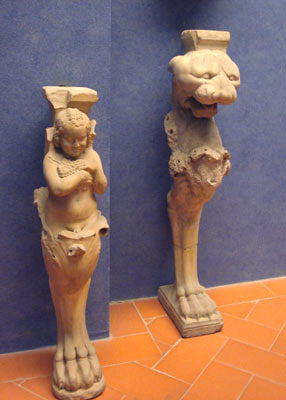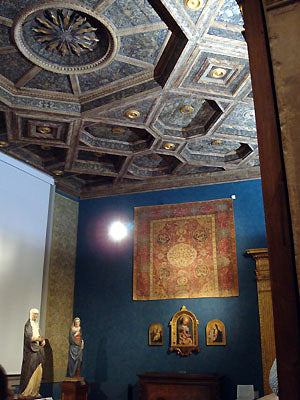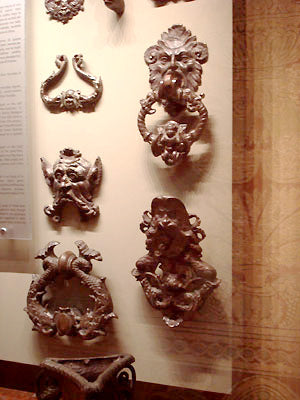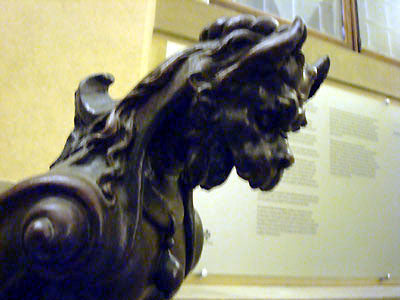---------------------
Museo Stefano Bardini - Florence, Italy
Florence, Italy, recently celebrated its "Notte Bianca"
(White Night). This is a night in which all of the famous central part
of the city comes out to play, even more than usual. Street performers
are out, wine and music are flowing, and there was a wonderfully dynamic
video installation projected over (and using) the architecture of the
Uffizi Gallery's Corridor.
One of the other perks is that some of the museums stayed open
late and were free to enter. So, I want to share with you some of the
jewels inside the Museo Stefano Bardini.
Stefano Bardini was an avid art collector and is said to
have had a natural ability to successfully display together works from
different time periods. The first thing that one must notice is that the
walls are a soft blue, very unlike the typically warm Tuscan yellows.
But the blues perfectly enhance the creamy colors in the stone
sculptures.
Perhaps I should admit one of my weaknesses: I rarely remember
the names of the artists or the titles of the works. I realize that is
perhaps unhealthy for a professional artist. However, especially in a
museum, I find myself overwhelmed with what I AM looking for, that the
labels often seem unimportant. Even as a child I was interested in the
idea more than the source, unless that source was essential to that
idea.
So, if you want to know more about the artwork that I am showing you, please visit the Museo Stefano Bardini. They also have more clear images on their site than the ones that I have shot here. See the full article with images here: https://borsheimarts.com/blogs/news/museo-stefano-bardini-florence-italy



I just love the two animals in the upper right corner of the image on the right. My favorite are the ears!


I first became interested in bas-relief sculpture after spending two days working with it in a sculpture workshop with Eugene Daub
many years ago. I learned then its potential and have since stopped
calling it "Puffy Painting." However, it has been Italy where I began to
appreciate the full range of what one can do in relief. Sculptors know
that we must carve for the light and we only can assume, for the most
part, that that light will come from above.
Look at the detail shot of the pulpit - can you see how the
artist maximized the use of undercuts to create the shadows necessary to
distinguish the form. If you really look at this stone carving in
relief, you will notice just how many different tones are there, based
soley on the way the stone was carved or how deep or angled an undercut
(narrow and angled creating a darker shadow). Brilliant! And lovely.



Oh, the expressiveness. Oh, the creativity. Oh, the technique.
Without electricity, these forms were cut from stone. Do you know how
difficult this really is?


Such magnificient and imaginative creatures. These carvings seem a bit
crudely created to me and yet, they have their own charm.


Really, I was so enchanted not only by the blue, but the way in which
busy carvings were put together with a harmony of line and simplicity.
Maybe from the Della Robbia studio, famous for the blue backgrounds on
white ceramic bas-relief sculptures.
These stairs remind me of Michelangelo's Biblioteca Medicea Laurenziana, also here in Firenze.

The ceilings are spectacular! What is amazing is that some of the
designs and executions may not appear complicated, but put together
over a large area, and ... wow, what an effect!





"The drawings in Bardini's collection were mainly ascribed to Giovan Battista Tiepolo (1696-1770) and his son Lorenzo (1736-1776)."
(I photographed the sign . . . )
"These bronze statuettes are ascribed to Severo da Ravenna's
workshop. They are really expressive and represent sea monsters, pagan
gods, winged dragons, lamps, acrobats and little naked angels,
licentious satyrs, candle holders and other profane subjects."
[sic, on the grammar]

"There is another lamp representing a licentious subject,
so as to instigate laughter when it was lit. These kinds of objects
were requested above all by humanists, often fond of studying nature.
That's why the bases were frequently cast on real animal legs, such as
the cock's foot on this lamp."




I found this crucified figure intriguing because his body did not fit
the shape of a cross. Perhaps I am crude to say that the abstract shape
appeals to me as having a graceful flow to it.
From the museum: "Over them [two figures not shown here] is hung a Crucified Thief,
of which the cross has been lost. In the 1918 New York auction
catalogue, Bardini presented the bronze as a work of Zaccaria da
Volterra, based on Michelangelo's design."
I do not understand how they can place this figure on a cross --
would not both feet have been secured? The lower arm was dangling from a
rope on the arm of the cross? The figure's back is as well formed as
the front. I am certainly no expert, but many sculptors only shape the
parts that will be seen. On the other hand, perhaps a slender cross
would allow spaces in which the
body could be viewed. In that case, a sculpture in the round would be much easier to create and better for a thorough viewing.



Now, here is a happy fellow in this center image! And displayed
among other bronze reliefs of madonnas and religious figures (not
shown).[I do apologize for the refection of my camera in this shot!]


It is sad to see the damage done to this wooden vessel. But what a glory piece she is!


While I am not personally much interested in weaponry, the part of me
that loves science fiction and fantasy art was intrigued by these spear
shapes. Perhaps the holes were made to make the metal lighter, but they
are still beautifully crafted.


Gotta love this: Naked guy angel on a gun? Just look at the size of those thighs! Mamma mia!



Stone, metal, wood: Sculpture is da bomb!


Oh, I wish that I had gotten a better image of this lion in restoration - this area was behind a locked glass door.
I know a tour guide for Florence who recently posted on Facebook that
although the Florentines used the lion as their symbol before they
adopted the current fleur-di-lis (different from France's), the
artists had never even seen a lion, other than looking at ancient
artworks. However, this lion is so much more elegant in form that it
makes me wonder . . . For example, I love that graceful triangular taper
from the rib cage to the hips.



Giambologna's frightful creature Diavolino (little devil) gives me a theory about where Dr. Seuss came up with "The Grinch that Stole Christmas".


I must say that I enjoyed this idea of wallpaper (in truth a fresco) turning out to be a curtain.



Maybe these works are not famous (the sculpture on the right is a
fountainhead), but I hope you recognize the artistry in them.
And I hope that I have left you wanting more.
-------------------
Recent Blog Topics:
Interested? Subscribe online at:
http://artbyborsheim.blogspot.com
(This is a different subscription list than the one for this art newsletter.)
That's it for now. I hope to see you soon!
Thank you for reading
and by all means, forward this newsletter to anyone you think would
enjoy it. All of the events mentioned here are open to the public.
Pace (peace),
Kelly Borsheim
5 May 2010
Sign-up to receive FREE e-news or printed mail.
Return to Read Other Newsletters - Table Of Contents Page
If you enjoy Borsheim Art News, please forward it to friends and
colleagues. It comes to you about 6-8 times a year from Cedar Creek,
Texas-based artist Kelly Borsheim.
Home | Contact Artist
Copyright © 2010 Kelly Borsheim
All Rights Reserved
| 














































